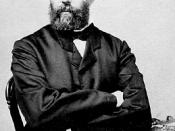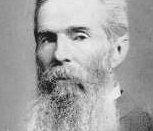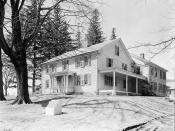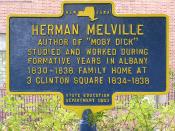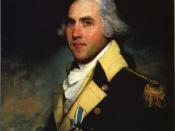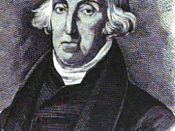Herman Melville is widely acclaimed as one of the greatest writers in history. His works such as Typee and Moby Dick prove that he had incredible talent for writing. Although Melville was a financial ruin throughout his life and his works did not receive much of the credit that was due to them, Melville is still regarded today as one of the greatest writers in American history.
Melville's heritage and youthful experiences were fairly important in forming the conflicts his artistic vision deals with. Herman Melville was born in New York City on Aug. 1, 1819, the third child of Allan and Maria Gansevoort Melvill, in a family that was to grow to four boys and four girls. ("Herman Melville" http://www.comptons.com) His family had been among the Scottish and Dutch settlers of New York and had taken leading roles in the American Revolution and in the fiercely competitive commercial and political life of the new country.
One grandfather, Major Thomas Melvill, was a member of the Boston Tea Party in 1773 and also had worked as a New York importer. The other, General Peter Gansevoort, was a friend of James Fenimore Cooper and famous for leading the defense of Fort Stanwix, in upstate New York, against the British. Herman was silent and slow. His mother regarded him as a dull boy. (http://www.comptons.com) In 1826 Allan Melvill wrote of his son: "He is very backward in speech & somewhat slow in comprehension, but you will find him as far as he understands men and things both solid and profound, and of a docile and amiable disposition." ("Concerning Herman Melville" http://www.melville.org/others.html) In that same year, scarlet fever left the boy with permanently weakened eyesight, but he attended Male High School. When the family import business collapsed in 1830, the family returned to Albany, where Herman enrolled briefly in Albany Academy. Allan Melvill died in 1832, leaving his family in a very poor financial situation. The eldest son, Gansevoort, assumed responsibility for the family and took over his father's felt and fur business. Herman joined him after two years as a bank clerk and some months working on the farm of his uncle, Thomas Melvill, in Pittsfield, Mass. About this time, Herman's branch of the family altered the spelling of its name. Though finances were unstable, Herman attended Albany Classical School in 1835 and became an active member of a local debating society. A teaching job in Pittsfield made him unhappy, however, and after three months he returned to Albany.
Melville had already begun writing, but the remainder of his youth became a search for security. The crisis that started Herman on his wanderings came in 1837, when Gansevoort went bankrupt and the family moved to nearby Lansingburgh (later Troy). In what was to be a final attempt at established employment, Herman studied surveying at Lansingburgh Academy to equip himself for a post with the Erie Canal project. When the job did not materialize, Gansevoort arranged for Herman to ship out as cabin boy on the "St. Lawrence," a merchant ship sailing in June 1839 from New York City for Liverpool. The summer voyage did not dedicate Melville to the sea, and on his return his family was dependent still on the charity of relatives. After a grueling search for work, he taught briefly in a school that closed without paying him. His uncle Thomas, who had left Pittsfield for Illinois, apparently had no help to offer when the young man followed him west. In January 1841 Melville sailed on the whaler "Acushnet," from New Bedford, Mass., on a voyage to the South Seas. This, along with many other voyages to sea, would greatly influence Melville in his works.
In June 1842 the "Acushnet" anchored in the Marquesas Islands in present-day French Polynesia. Melville's adventures here, while somewhat exaggerated, became the subject of his first novel, Typee (1846). In July Melville and a companion jumped ship and, according to Typee, spent about four months as guest-captives of the reputedly cannibalistic Typee people. Actually, in August he was registered in the crew of the Australian whaler "Lucy Ann.". Despite the nature of the situation and the reputation of the Typee people, Melville represented the valley of the Typees as a sanctuary from a hustling, aggressive civilization.
"For Melville seems already to have been the good storyteller who was later to astound Mrs. Nathaniel Hawthorne with his vividness, and his sisters and their friends. They thrilled to his dangers and could be easily teased by ambiguous references to South Sea maidens who were as charming as any from Lansingburgh or Boston but who's impulses were considered less (as everybody knew) were considered less inhibited. Furthermore, the Typee's were widely known as man-eaters and although Melville had never known a human being to pass their lips he was not averse to taking advantage of their reputation for the sake of suspense. From the very beginning Melville played a game with his audience as he strung out his stories to book-length with picturesque descriptions, details from memory, and other details gathered in reference books." (Unger 75-76) Although Melville was down for a 120th share of the whaler's proceeds, the voyage had been unproductive. He joined a mutiny that landed the mutineers in a Tahitian jail, from which he escaped without difficulty. On these events, Melville based his second book, Omoo (1847). Cheerful in tone, with the mutiny shown as something of horseplay, it describes Melville's travels through the islands, accompanied by Long Ghost, formerly the ship's doctor, now turned drifter.
These travels, in fact, occupied less than a month. In November he signed as a harpooner on his last whaler, the "Charles & Henry," out of Nantucket, Mass. Six months later he disembarked at Lahaina, in the Hawaiian Islands. Somehow he supported himself for more than three months; then in August 1843 he signed as an ordinary seaman on the frigate "United States," which in October 1844 discharged him in Boston.
Melville rejoined a family whose prospects had much improved.
In Lansingburgh the four years of Melville's absence had brought a degree of improvement in the family fortunes. The return of better times to the nation's economy, while not restoring former prosperity, had at least started the Melvilles toward financial and social recovery. Gansevoort had become a persuasive orator in the presidential campaign of James Polk. Allan, long the problem child of the family, was making good as a lawyer on Wall Street. (Hillway 39) Encouraged by his family's enthusiastic reception of his tales of the South Seas, Melville wrote them down. The years of acclaim were about to begin for Melville.
Typee provoked immediate enthusiasm and outrage, and then a year later Omoo had an identical response. Gansevoort, dead of a brain disease, never saw his brother's career flourish, but the tragedy left Melville head of the family and the more committed to writing to support it. Another responsibility came with his marriage in August 1847 to Elizabeth Shaw, daughter of the chief justice of Massachusetts. He tried unsuccessfully for a job in the U.S. Treasury Department, the first of many failing efforts to secure a government post.
In 1847 Melville began a third book, Mardi (1849), and became a regular contributor of reviews and other pieces to a literary journal. To his new literary acquaintances in New York City he appeared the character of his own books. He requested his publisher not to call him "the author of Typee and Omoo," for his third book was to be different. When it appeared, public and critics alike found its wild fantasy and variety of styles incomprehensible. It began as another Polynesian adventure but quickly set its hero in pursuit of the mysterious Yillah, "all beauty and innocence," a symbolic quest that ends in disaster. In an attempt to hide his disappointment at the book's reception, Melville quickly wrote Redburn (1849) and White-Jacket (1850) in the manner expected of him.
"I have read Melville's works with a progressive appreciation of the author. No writer ever put the reality before his reader more unflinchingly than he does in Redburn, and White Jacket. Mardi is a rich book, with depths here and there that compel a man to swim for his life. It is so good that one scarcely pardons the writer for not having brooded long over it, so as to make it a great deal better." ("Concerning Herman Melville" http://www.melville.org/others.html) In October 1849 Melville sailed to England to resolve his London publisher's doubts about White-Jacket. He also visited the Continent, kept a journal, and arrived back in America in February 1850. The critics acclaimed White-Jacket, and its powerful criticism of abuses in the U.S. Navy won it strong political support. But both novels, however much they seemed to revive the Melville of Typee, had passages of deep sadness. It was not the same Melville who wrote them. A fresh influence was supplied by Nathaniel Hawthorne's Scarlet Letter, a novel exploring good and evil in the human being, which Melville read in the spring of 1850. That summer, Melville bought a farm, which he christened "Arrowhead," near Hawthorne's home at Pittsfield, and the two men became neighbors.
Melville had promised his publishers for the autumn of 1850 the novel first entitled The Whale, finally Moby Dick.
The central theme of this novel is the conflict between Captain Ahab, master of the whaler Pequod, and Moby-Dick, a great white whale that once tore off one of Ahab's legs at the knee. Ahab is dedicated to revenge; he drives himself and his crew, which includes Ishmael, the narrator of the story, over the seas in a desperate search for his enemy. ("Herman Melville" http://www.encarta.msn.com) Melville's influence for this novel was undoubtedly his experiences on whalers and his adventures on the seas. Without his voyages on the seas he would not have had the background on whaling necessary to write such a masterpiece.
His delay in submitting it was caused less by his early-morning chores as a farmer than by his explorations into the views opened for him by Hawthorne. Their relationship revived Melville's creative energies. Melville was deeply inspired by the writings of Hawthorne. To the cooler, withdrawn Hawthorne, such depth of feeling was not agreeable with Hawthorne. The two men gradually drew apart. They met for the last time, almost as strangers, in 1856, when Melville visited Liverpool, where Hawthorne was American consul.
Moby Dick was published in London in October 1851 and a month later in America.
Moby Dick: Or, The Whale is Melville's masterpiece, the book in which he most thoroughly used his experiences in the South Seas to examine the human condition and the metaphysical questions that were at the center of the author's troubled worldview. (Magill 1328) It brought its author neither acclaim nor reward. In the distorted magnificence of Captain Ahab and in the beauties and terrors of the voyage of the "Pequod," however, Melville dramatized his deeper concerns: the defeats and triumphs of the human spirit and its combination of creative and violent urges.
The lack of an adequate income plagued Melville and forced him to continue writing. He had earned an average of $1200 for each of his first six books. Through advances he had been able to secure about $700 in cash for his expenses during the winter of 1851-52, but by now his account with Harper and Brothers, his American publisher, had been overdrawn by more than $400. (Hillway 46-47) Pierre was to be his next work. It was a very personal work, revealing the background of his private life. The novel is structured in terms of a story of an artist alienated from his society. Pierre was written to appeal to feminine readers. In it can be found the humiliated responses to poverty that his youth supplied him and the hypocrisy he found beneath his father's claims to purity and faithfulness. The novel, a slightly hidden tale of Melville's own dark thoughts, was rooted in these relations. When published, it was another critical and financial disaster. Only 33 years old, Melville saw his career in ruins. Near breakdown, and having to face in 1853 the disaster of a fire at his New York publishers that destroyed most of his books, Melville continued with writing.
In 1856 Melville set out on a tour of Europe and the Levant to renew his spirits. The most powerful passages of the journal he kept are in harmony with The Confidence-Man (1857), a satire on an America corrupted by the dreams of commerce. This was the last of his novels to be published in his lifetime. Three American lecture tours were followed by his final sea journey, in 1860, when he joined his brother Thomas, captain of the clipper "Meteor," for a voyage around Cape Horn. He abandoned the trip in San Francisco.
Melville abandoned the novel for poetry, but the chances for publication were not favorable. With two sons and daughters to support, Melville sought government patronage. A consul post he pursued in 1861 went elsewhere. On the outbreak of the Civil War, he volunteered for the Navy, but was again rejected. He had apparently returned full cycle to the insecurity of his youth, but an inheritance from his father-in-law brought some relief and "Arrowhead," increasingly a burden, was sold. By the end of 1863, the family was living in New York City. The war was much on his mind and furnished the subject of his first volume of verse, Battle-Pieces and Aspects of the War (1866). Four months after it appeared, an appointment as a customs inspector on the New York docks finally brought him a secure income.
Despite poor health, Melville began a pattern of writing evenings, weekends, and on vacations. In 1867 his son Malcolm shot himself, accidentally the jury decided, though it appeared that he had quarrelled with his father the night before his death. His second son, Stanwix, who had gone to sea in 1869, died in a San Francisco hospital in 1886 after a long illness. Throughout these griefs, and for the whole of his 19 years in the customs house, Melville's creative pace was understandably slowed.
His second collection of poetry, John Marr, and Other Sailors; With Some Sea-Pieces, appeared in 1888. By then he had been in retirement for three years, assisted by legacies from friends and relatives. About 3 years later he wrote Timoleon (1891), a final poetry collection. More significant was the return to style that was revealed in his last work, the novel Billy Budd, which remained unpublished until 1924. Provoked by a false charge, the sailor Billy Budd accidentally kills the satanic master-at-arms. In a time of threatened mutiny he is hanged, going willingly to his fate. Evil has not wholly triumphed, and Billy's memory lives on as an emblem of good.
Billy Budd was written during Melville's final years. He may have begun it after reading "The Mutiny of the Somers" in The American Magazine in June, 1888. Melville's cousin Guert Gansevoort had been a lieutenant on the US brig-of-war Somers in 1842 and had been a member of the military court that condemned a young seaman accused of mutiny. Melville may have wanted an opportunity to interpret this situation. (Magill 1331) The manuscript ends with the date April 19, 1891. Five months later Melville died. His life was neither happy nor successful. By the end of the 1840s he was among the most celebrated of American writers, yet his death evoked but a single obituary notice.
Melville's was provided with influences for his writings throughout his entire lifetime. A poverty-stricken childhood and issued within his family became the inspiration for the novel Pierre. Years later, after his father's death, he took a cabin boy position on board the whaler "Acushnet". This voyage took him to the South Seas and to the Marquesas Islands where he was held captive by the cannibalistic Typee people. His four month stay here became the influence for his first novel, Typee. When he escaped from the Typee and boarded the Australian whaler "Lucy Ann" he sailed in an unproductive journey and was placed in a Tahitian jail after a mutiny. This became the influence behind his second book, Omoo. Mardi was a slighly different style. Unlike Typee and Omoo, which were slightly exaggerated depictions of his adventures on the sea and throughout the islands, Mardi blended some elements of fantasy with his Polynesian experiences. In Melville's first three books the influences that sailing had on him remained very important. Melville's oceanic influences remained constant with the novel White Jacket, for which he drew upon his experiences in the Navy to write an acclaimed criticism of the treatment of sailors in the Navy. The influences that the sea and sailing had on Melville were probably most apparent in his masterpiece Moby Dick. Such an acclaimed novel could not have been written had he not experienced numerous adventures on the sea. Aside from his experiences and hardships in his early years with his family, which influenced his writing of Pierre, Melville's main influence is clearly his travels of the seas and to a lesser extent, his adventures throughout the various islands he visited throughout his voyages.
Despite changes within society and within Melville's life, his writings never lost sight of reality. His symbols grew from such visible facts, made present, as the dying whales, the mess of blubber, and the wood of the ship, in Moby Dick. It was Melville's triumph that he endured, recording his vision to the end. After the years of neglect, modern criticism has secured his reputation with that of the great American writers.
